

The Parts of Human Speech Organs & Their Definitions

Types of Phonetics
Imagine being unable to verbally respond to a verbal greeting. Thinking about the ability to speak as an important part of your day may not cross your mind. If that speech ability was taken away, you might find yourself unable to communicate not only basic speech but also emotional responses like fear, confusion or anxiety. Although you may not give your speech organs much thought, they are integrally tied to how you function. From the lungs to the mouth, the organs of speech and their function in sound production and speech play important roles in many aspects of your life.
Breathing and Speaking Connections
Looking at the speech mechanism and organs of speech begins with the vital lungs. The lungs are located in the chest cavity and expand and contract to push air out of the mouth. Simple airflow is not enough to produce speech. The airflow must be modified by other speech organs to be more than just respiration. When you exhale, air moves out of your lungs through your windpipe or trachea. At the top of the trachea is one of the other primary organs of speech: the larynx or voice box.
Vibrations of the Larynx
Three more parts of the speech mechanism and organs of speech are the larynx, epiglottis and vocal folds. The larynx is covered by a flap of skin called the epiglottis. The epiglottis blocks the trachea to keep food from going into your lungs when you swallow. Across the larynx are two thin bands of tissue called the vocal folds or vocal cords. Depending on how the folds are positioned, air coming through the trachea makes them vibrate and buzz. These vibrations are called a "voiced" or soft sound. Placing finger tips over the Adam's apple or larynx at the front of your neck while humming makes it possible to feel the vocal fold vibration.
Articulators of Speech
The inside of your mouth is also called the oral cavity and controls the shape of words. At the back of the oral cavity on the roof of the mouth is the soft palate or velum. When you pronounce oral sounds, such as "cat" or "bag," the velum is located in the up position to block air flow through the nasal cavity. When you pronounce nasal sounds, such as "can" or "mat," the velum drops down to allow air to pass through the nasal cavity. In front of the velum is the hard palate. Your tongue presses or taps against the hard palate when you pronounce certain words, such as "tiptoe." Developmental or physical issues related to speech organs that are articulators of speech can result in a need for speech therapy.
Teeth, Tongue and Lips
Say "Thank you." Feel how your tongue presses against the inside of your front teeth. The convex area directly behind your teeth is known as the teeth ridge. For the purpose of linguistics, the tongue is divided into three regions: the blade, front and back. The tip of the tongue, which touches the teeth ridge, is called the blade. The middle of the tongue, which lines up with the hard palate, is called the front of the tongue. Finally, beneath the soft palate is the back of the tongue. The final speech organ is the most visible and obvious: the lips. Your lips influence the shape of the sounds leaving the oral cavity. Each of these organs of speech and their definitions is important to the process of speech, articulation and expressions through sounds.
Related Articles

How to Transcribe Words Into IPA Format

How to Articulate for Effective Speaking

Medical Terminology Exercises

Examples of Diffusion in Organs

How to Teach Kids About Germs & Hygiene

How to Encode & Decode a Communication Model

Effective Uses of Verbal Communication

Speech Techniques for High School
- The University of Iowa: Three Parts of Speech
- Aston University: How Sound is Produced
- The Scientist: Why Human Speech is Special
Carolyn Robbins began writing in 2006. Her work appears on various websites and covers various topics including neuroscience, physiology, nutrition and fitness. Robbins graduated with a bachelor of science degree in biology and theology from Saint Vincent College.

Want to create or adapt books like this? Learn more about how Pressbooks supports open publishing practices.
2.2 The Articulatory System
We speak by moving parts of our vocal tract (See Figure 2.1). These include the lips, teeth, mouth, tongue and larynx. The larynx or voice box is the basis for all the sounds we produce. It modified the airflow to produce different frequencies of sound. By changing the shape of the vocal tract and airflow, we are able to produce all the phonemes of spoken language. There are two basic categories of sound that can be classified in terms of the way in which the flow of air through the vocal tract is modified. Phonemes that are produced without any obstruction to the flow of air are called vowels . Phonemes that are produced with some kind of modification to the airflow are called consonants . Of course, nature is not as clear-cut as all that and we do make some sounds that are somewhere in between these two categories. These are called semivowels and are usually classified alongside consonants as they behave similar to them.
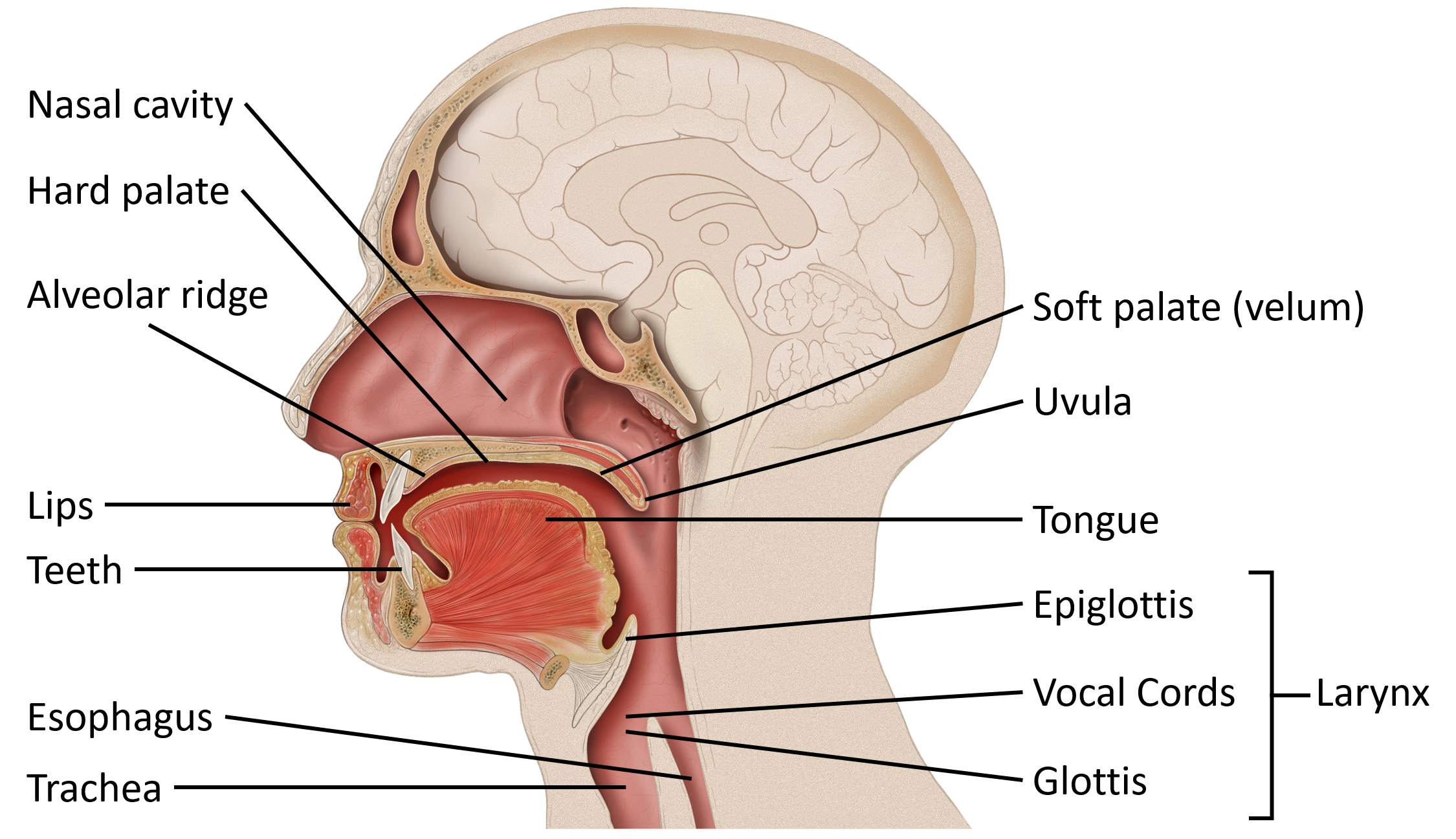
While vowels do not require any modifications to the airflow, the production of consonants requires it. This obstruction is produced by bringing some parts of the vocal tract into contact. These places of contact are known as places of articulation . As seen in Figure 2.2, there are a number of places of articulation for the lips, teeth, and tongue. Sometimes the articulators touch each other as in the case of the two lips coming together to produce [b]. At other times, two articulators come into contact as when the lower lip folds back into the upper teeth to produce [f]. The tongue can touch different parts of the vocal tract to produce a variety of consonants by touching the teeth, the alveolar ridge, hard palate or soft palate (or velum).
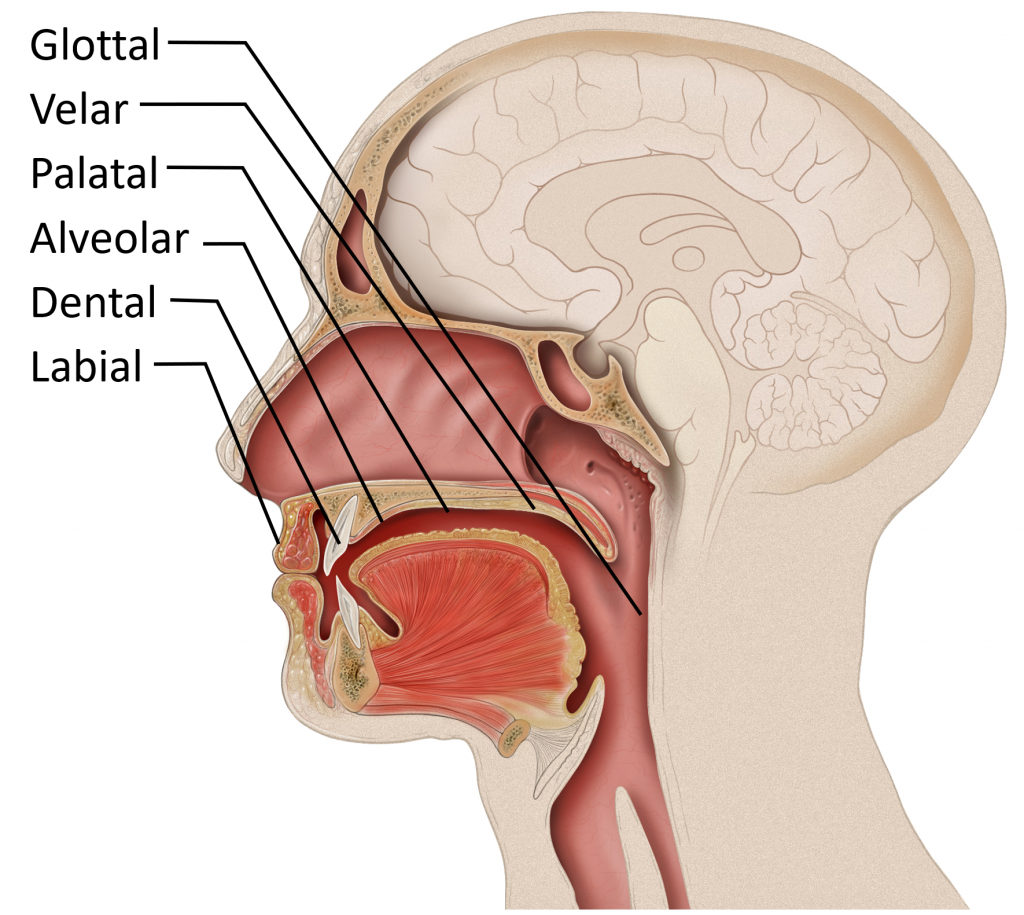
While these places of articulation are sufficient for describing how English phonemes are produced, other languages also make use of the glottis and epiglottis among other parts of the vocal tract. We will explore these in more detail later.
The Vocal Tract
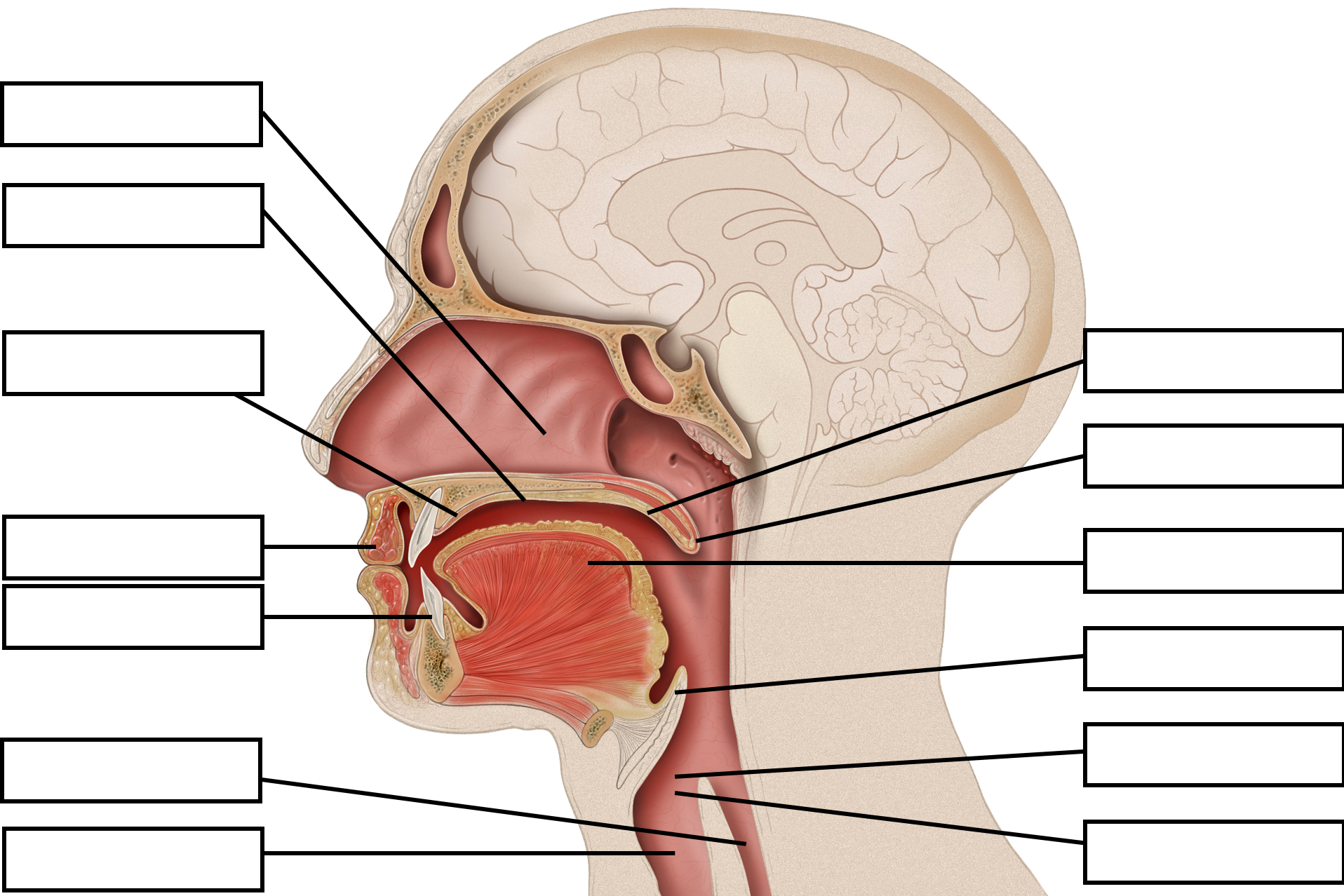
Fill in the blanks with parts of vocal tract:
- Hard palate
- Soft palate
- Nasal cavity
- Alveolar ridge
- Vocal cords
To check your answers, navigate to the above link to view the interactive version of this activity.
Places of Articulation
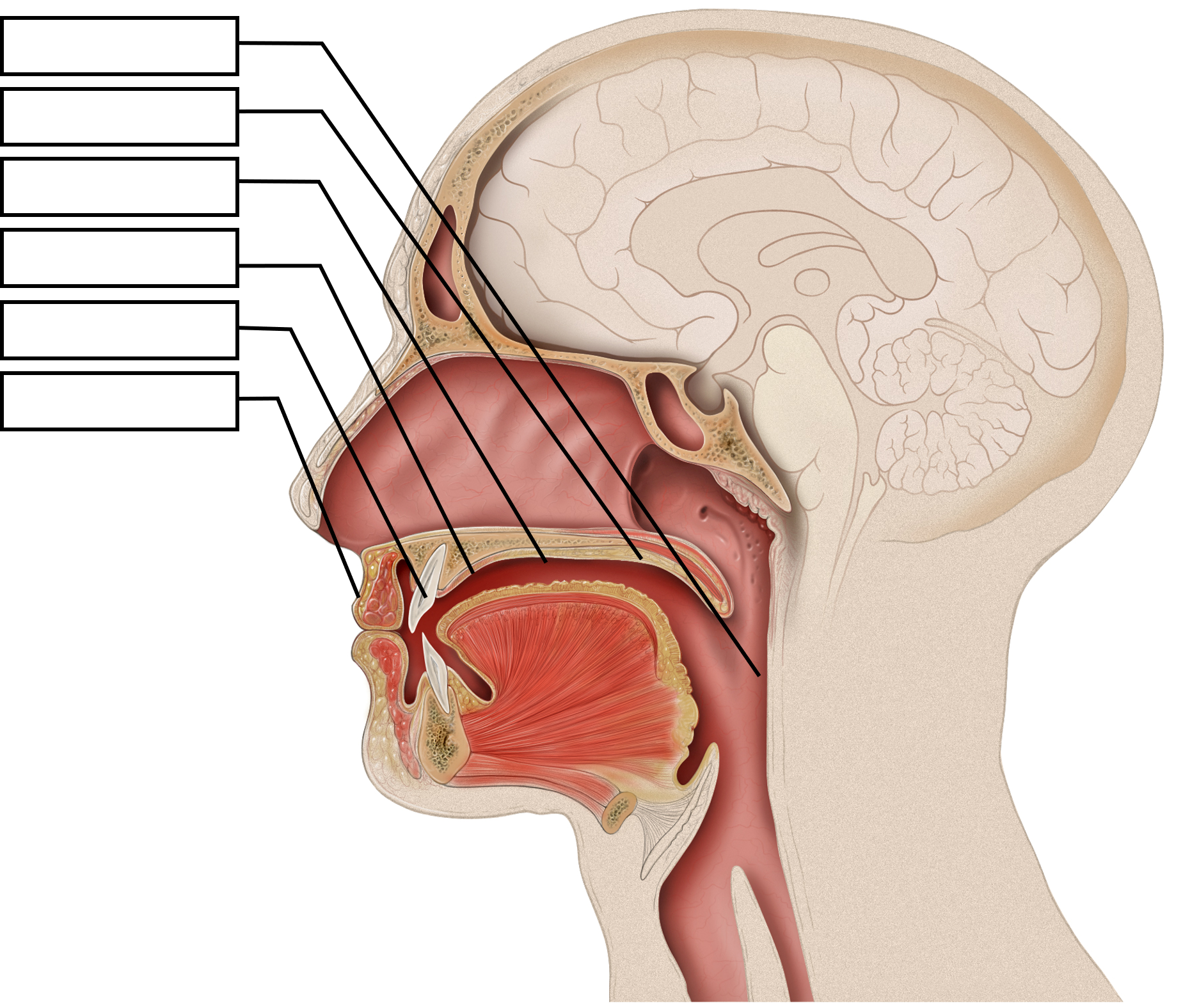
Image description
Figure 2.1 Parts of the Human Vocal Tract
A labeled image of the anatomical components of the human vocal tract, including the nasal cavity, hard palate, soft palate or velum, alveolar ridge, lips, teeth, tongue, uvula, esophagus, trachea, and the parts of the larynx, which include the epiglottis, vocal cords, and glottis.
[Return to place in the text (Figure 2.1)]
Figure 2.2 Places of Articulation
A labeled image illustrating the anatomical components of the human vocal tract that are involved in English phonemes. These include the glottal, velar, palatal, dental, and labial structures.
[Return to place in the text (Figure 2.2)]
Media Attributions
- Figure 2.1 Parts of the Human Vocal Tract is an edited version of Mouth Anatomy by Patrick J. Lynch, medical illustrator, is licensed under a CC BY 2.5 licence .
- Figure 2.2 Places of Articulation is an edited version of Mouth Anatomy by Patrick J. Lynch, medical illustrator, is licensed under a CC BY 2.5 licence .
A speech sound that is produced without complete or partial closure of the vocal tract.
A speech sound that is produced with complete or partial closure of the vocal tract.
A consonant that is phonetically similar to a vowel but functions as a consonant. Also known as a glide.
The point of contact between the articulators.
Psychology of Language Copyright © 2021 by Dinesh Ramoo is licensed under a Creative Commons Attribution 4.0 International License , except where otherwise noted.
Share This Book

Want to create or adapt books like this? Learn more about how Pressbooks supports open publishing practices.
2.1 How Humans Produce Speech
Phonetics studies human speech. Speech is produced by bringing air from the lungs to the larynx (respiration), where the vocal folds may be held open to allow the air to pass through or may vibrate to make a sound (phonation). The airflow from the lungs is then shaped by the articulators in the mouth and nose (articulation).
Check Yourself
Video script.
The field of phonetics studies the sounds of human speech. When we study speech sounds we can consider them from two angles. Acoustic phonetics , in addition to being part of linguistics, is also a branch of physics. It’s concerned with the physical, acoustic properties of the sound waves that we produce. We’ll talk some about the acoustics of speech sounds, but we’re primarily interested in articulatory phonetics , that is, how we humans use our bodies to produce speech sounds. Producing speech needs three mechanisms.
The first is a source of energy. Anything that makes a sound needs a source of energy. For human speech sounds, the air flowing from our lungs provides energy.
The second is a source of the sound: air flowing from the lungs arrives at the larynx. Put your hand on the front of your throat and gently feel the bony part under your skin. That’s the front of your larynx . It’s not actually made of bone; it’s cartilage and muscle. This picture shows what the larynx looks like from the front.
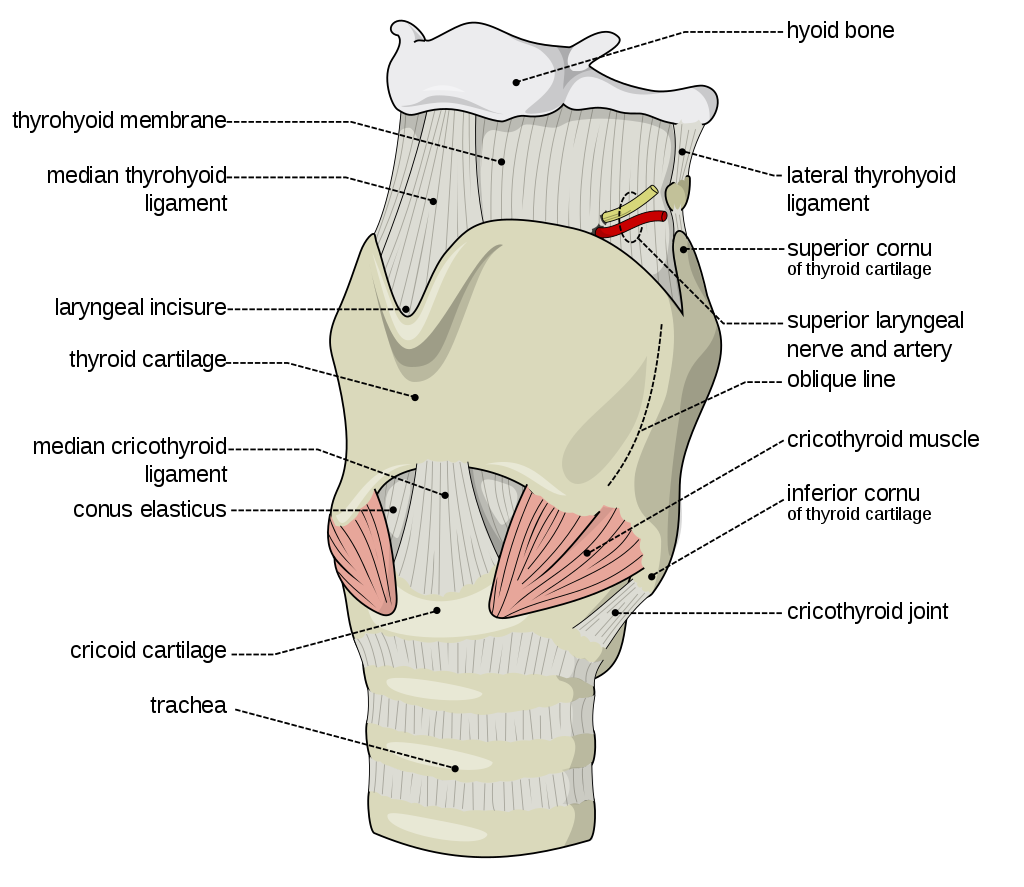
This next picture is a view down a person’s throat.
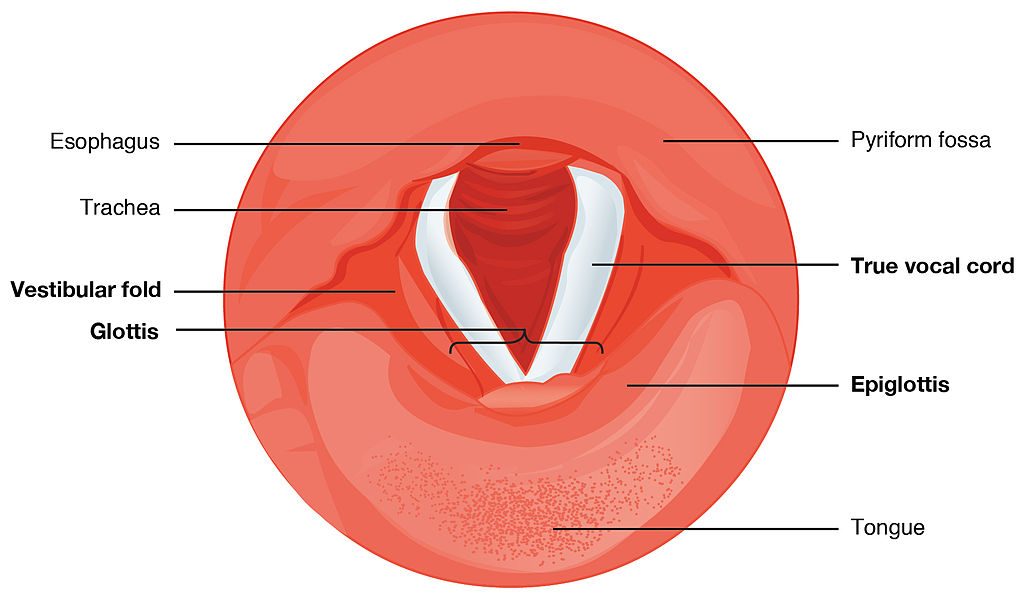
What you see here is that the opening of the larynx can be covered by two triangle-shaped pieces of skin. These are often called “vocal cords” but they’re not really like cords or strings. A better name for them is vocal folds .
The opening between the vocal folds is called the glottis .
We can control our vocal folds to make a sound. I want you to try this out so take a moment and close your door or make sure there’s no one around that you might disturb.
First I want you to say the word “uh-oh”. Now say it again, but stop half-way through, “Uh-”. When you do that, you’ve closed your vocal folds by bringing them together. This stops the air flowing through your vocal tract. That little silence in the middle of “uh-oh” is called a glottal stop because the air is stopped completely when the vocal folds close off the glottis.
Now I want you to open your mouth and breathe out quietly, “haaaaaaah”. When you do this, your vocal folds are open and the air is passing freely through the glottis.
Now breathe out again and say “aaah”, as if the doctor is looking down your throat. To make that “aaaah” sound, you’re holding your vocal folds close together and vibrating them rapidly.
When we speak, we make some sounds with vocal folds open, and some with vocal folds vibrating. Put your hand on the front of your larynx again and make a long “SSSSS” sound. Now switch and make a “ZZZZZ” sound. You can feel your larynx vibrate on “ZZZZZ” but not on “SSSSS”. That’s because [s] is a voiceless sound, made with the vocal folds held open, and [z] is a voiced sound, where we vibrate the vocal folds. Do it again and feel the difference between voiced and voiceless.
Now take your hand off your larynx and plug your ears and make the two sounds again with your ears plugged. You can hear the difference between voiceless and voiced sounds inside your head.
I said at the beginning that there are three crucial mechanisms involved in producing speech, and so far we’ve looked at only two:
- Energy comes from the air supplied by the lungs.
- The vocal folds produce sound at the larynx.
- The sound is then filtered, or shaped, by the articulators .
The oral cavity is the space in your mouth. The nasal cavity, obviously, is the space inside and behind your nose. And of course, we use our tongues, lips, teeth and jaws to articulate speech as well. In the next unit, we’ll look in more detail at how we use our articulators.
So to sum up, the three mechanisms that we use to produce speech are:
- respiration at the lungs,
- phonation at the larynx, and
- articulation in the mouth.
Essentials of Linguistics Copyright © 2018 by Catherine Anderson is licensed under a Creative Commons Attribution-ShareAlike 4.0 International License , except where otherwise noted.
Share This Book

An official website of the United States government
Here's how you know
Official websites use .gov A .gov website belongs to an official government organization in the United States.
Secure .gov websites use HTTPS A lock ( Lock A locked padlock ) or https:// means you've safely connected to the .gov website. Share sensitive information only on official, secure websites.

How Does the Human Body Produce Voice and Speech?: Text Version
[ back to infographic ]
How Does the Human Body Produce Voice and Speech?
Speech is produced by several parts of the body working together to shape the sounds of the voice.
Voice is generated by airflow from the lungs.
When the air from the lungs blows through the vocal folds at a high speed, the vocal folds vibrate.
The vibrations lead to sounds we call voice. These sounds are shaped to form speech.
When it's time to speak, the air pressure below the larynx increases until it blows the vocal folds apart.
3. Vocal Folds
The pressure forces the air through the vocal folds, creating suction as we exhale.
To produce speech, the vocal folds must vibrate normally as air travels through them from the lungs and reaches the mouth and nose.
4. Mouth and Nose
Coordinated movements, mainly by the tongue and lips in the nasal passages, produce recognizable sounds called speech.
More information: https://www.nidcd.nih.gov/voice-speech-video
- Increase Font Size
6 Mechanism of Speech Production
Dr. Namrata Rathore Mahanta
Learning outcome:
This module shall introduce the learner to the various components and processes that are at work in the production of human speech. The learner will also be introduced to the application of speech mechanism in other domains such as medical sciences and technology. After reading the module the learner will be able to distinguish speech from other forms of human communication and will be able to describe in detail the stages and processes involved in the production of human speech.
Introduction : What is speech and why it an academic discipline?
Speech is such a common aspect of human existence that its complexity is often overlooked in day to day life. Speech is the result of many interlinked intricate processes that need to be performed with precision. Speech production is an area of interest not only for language learners, language teachers, and linguists but also people working in varied domains of knowledge. The term ‘speech’ refers to the human ability to articulate thoughts in an audible form. It also refers to the formal one sided discourse delivered by an individual, on a particular topic to be heard by an audience.
The history of human existence and enterprise reveals that ‘speech’ was an empowering act. Heroes and heroines in history used ‘speech’ in clever ways to negotiate structures of power and overcome oppression. At times when the written word was an attribute of the elite and noble classes ‘speech’ was the vehicle which carried popular sentiments. In adverse times ‘speech’ was forbidden or regulated by authority. At such times poets and ordinary people sang their ‘speech’ in double meaning poems in defiance to authority. In present times the debate on an individual’s ‘right to free speech’ is often raised in varied contexts. As an academic discipline Speech Communication gained prominence in the 20th century and is taught in university departments across the globe. Departments of Speech Communication offer courses that engage with the speech interactions between people in public and private domain, in live as well as technologically mediated situations.
However, the student who peruses a study of ‘mechanism of speech production’ needs to focus primarily on the process of speech production. Therefore, the human brain and the physiological processes become the principal areas of investigation and research. Hence in this module ‘speech’ is delimited to the physiological processes which govern the production of different sounds. These include the brain, the respiratory organs, and the organs in our neck and mouth. A thorough understanding of the mechanism of speech production has helped correct speech disorders, simulate speech through machines, and develop devices for people with speech related needs. Needless to say, teachers of languages use this knowledge in the classroom in a variety of ways.
Speech and Language
In everyday parlance the terms ‘speech’ and ‘language’ are often used as synonyms. However, in academic use these two terms refer two very different things. Speech is the ‘spoken’ and ‘heard’ form of language. Language is a complex system of reception and expression of ideas and thoughts in verbal, non-verbal and written forms. Language can exist without speech but speech is meaningless without language. Language can exist in the mind in the form of a thought, on paper/screen in its orthographic form; it can exist in a gesture or action in its non-verbal form, it can also exist in a certain way of looking, winking or nodding. Thus speech is only a part of the vast entity of language. It is the verbal form of language.
Over the years Linguists have engaged themselves with the way in which speech and language exists within the human beings. They have examined the processes by which language is acquired and learnt. The role of the individual human being, the role of the society/community/the genetic or physiological attributes of the human beings all been investigated from time to time.
Ferdinand de Saussure a Swiss linguist who laid the foundation for Structuralism declared that language is imbibed by the individual within in a society or community. His lectures delivered at the University of Geneva during 1906-1911 were later collected and published in 1916 as Cours de linguistique générale . Saussure studied the relationship between speech and the evolution of language. He described language as a system of signs which exists in a pattern or structure. Saussure described language using terms such as ‘ langue ’ ‘ parole ’ and ‘langage ’. These terms are complex and cannot be directly translated. It would be misleading to equate Saussure’s ‘ langage ’ with ‘language’. However at an introductory stage these terms can be described as follows:
American linguist Avram Noam Chomsky argued that the human mind contains the innate source of language and declared that humans are born with a mind that is pre-programmed for language, i.e., humans are biologically programmed to use languages. Chomsky named this inherent human trait as ‘Innate Language’. He introduced two other significant terms: ‘Competence’ and ‘Performance’
‘Competence’ was described as the innate knowledge of language and ‘Performance’ as its actual use. Thus the concepts of ‘Innate Language’ ‘Language Competence’ and ‘Language Performance’ emerged and language came to be accepted as a cognitive attribute of humans while speech came to be accepted as one of the many forms of language communication. These ideas can be summarized in the chart given below:
In the present times speech and language are seen as interdependent and complementary attributes of humans. Current research focuses on finding the inner connections between speech and language. Consequently, the term ‘Speech and Language’ is used in most application based areas.
From Theory to Application
It is interesting to note that the knowledge of the intricacies of speech mechanism is used in many real life applications apart from Language and Linguistics. A vibrant area in Speech and Language application is ‘Speech and Language Processing’. It is used in Computational Linguistics, Natural Language Processing, Speech Therapy, Speech Recognition and many more areas. It is used to simulate speech in robots. Vocoders and Text to speech function (TTS) also makes use of speech mechanism. In Medical Sciences it is used to design therapy modules for different speech and language disorders, to develop advanced gadgets for persons with auditory needs. In Criminology it is used to recognize speech patterns of individuals and to identify manipulations in recorded speech patterns. Speech processing mechanism is also used in Music and Telecommunication in a major way.
What is Speech Mechanism?
Speech mechanism is a function which starts in the brain, moves through the biological processes of respiration, phonation and articulation to produce sounds. These sounds are received and perceived through biological and neurological processes. The lungs are the primary organs involved in the respiratory stage, the larynx is involved in the phonation stage and the organs in the mouth are involved in the articulatory stage.
The brain plays a very important role in speech. Research on the human brain has led to identification of certain areas that are classically associated with speech. In 1861, French physician Pierre Paul Broca discovered that a particular portion of the frontal lobe governed speech production. This area has been named after him and is known as Broca’s area. Injury to this area is known to cause speech loss. In 1874, German neuropsychiatrist Carl Wernicke discovered that a particular area in the brain was responsible for speech comprehension and remembrance of words and images. At a time when brain was considered to be a single organ, Wernicke demonstrated that the brain did not function as a single organ but as a multi pronged organ with distinctive functions interconnected with neural networks. His most important contribution was the discovery that brain function was dependent on these neural networks. Today it is widely accepted that areas of the brain that are associated with speech are linked to each other through complex network of neurons and this network is mostly established after birth, through life experience, over a period of time.
It has been observed that chronology and patterning of these neural networks differ from individual to individual and also within the same individual with the passage of time or life experience. The formation of new networks outside the classically identified areas of speech has also been observed in people who have suffered brain injury at birth or through life experience. Although extensive efforts are being made to replicate or simulate the plasticity and creativity of the human brain, complete replication has not been achieved. Consequently, complete simulation of human speech mechanism remains elusive.
The organs of speech
In order to understand speech mechanism one needs to identify the organs used to produce speech. It is interesting to note that each of these organs has a unique life-function to perform. Their presence in the human body is not for speech production but for other primary bodily functions. In addition to primary physiological functions, these organs participate in the production of speech. Hence speech is said to be the ‘overlaid’ function of these organs. The organs of speech can be classified according to their position and function.
- The respiratory organs consist of: The Lungs and trachea. The lungs compress air and push it up the trachea.
- The phonatory organs consist of the Larynx: The larynx contains two membrane- like structures called vocal cords or vocal folds. The vocal folds can come together or move apart.
- The articulatory organs consist of : lips, teeth, roof of mouth, tongue, oral and nasal cavities
The respiratory process involves the movement of air. Through muscle action of the lungs the air is compressed and pushed up to pass through the respiratory tract- trachea, larynx, pharynx, oral cavity, nasal cavity or both. While breathing in, the rib cage is expanded, the thoracic capacity is enlarged and lung volume is increased. Consequently, the air pressure in lungs drops down and the air is drawn into the lungs. While breathing out, the rib cage is contracted, the thoracic capacity is diminished and lung volume is decreased. Consequently, the air pressure in the lungs exceeds the outside pressure and air is released from the lungs to equalize it. Robert Mannel has explained the process through flowcharts and diagrammatic representations given below:
Once the air enters the pharynx, it can be expelled either through the oral passage, or through the nasal passage or through both depending upon the position of soft movable part of the roof of the mouth known as soft palate or velum.
Egressive and Ingressive Airstream: If the direction of the airstream is inward, it is termed as ‘Ingressive airstream. If the direction of the airstream is outward, it is ‘Egressive airstream’. Most languages of the world make use of Pulmonic Egressive airstream. Ingressive airstream is associated with Scandinavian languages of Northern Europe. However, no language can claim to use exclusively Ingressive or Egressive airstreams. While most languages of the world use predominantly Egressive airstreams, they are also known to use Ingressive airstreams in different situations. For extended list of use of ingressive mechanism you may visit Robert Eklund’s Ingressive Phonation and Speech page at www.ingressive.info .
Egressive process involves outward expulsion of air. Ingressive process involves inward intake of air. Egressive and Ingressive airstreams can be pulmonic (involving lungs) or non-pulmonic (involving other organs).
Non Pulmonic Airstreams: There are many languages which make use of non pulmonic airstream. In these cases the air expelled from the lungs is manipulated either in the pharyngeal cavity, or in the vocal tract, or in the oral cavity. Three major non pulmonic airstreams are:
In Ejectives, the air is trapped and compressed in the pharyngeal cavity by an obstruction in the mouth with simultaneous closure of the glottis. The larynx makes an upward movement which coincides with the removal of the obstruction causing the air to be released.
In Implosives, the air is trapped and compressed in the pharyngeal cavity by an obstruction in the mouth with simultaneous closure of the glottis. The larynx makes a downward movement which coincides with the removal of the obstruction causing the air to be sucked into the vocal tract.
In Clicks, the air is trapped and compressed in the oral cavity by lowering of the soft palate or velum and simultaneous closure of the mouth. Sudden opening causes air to be sucked in making a clicking sound. For a list of languages which use these airstream mechanisms you may visit https://community.dur.ac.uk/daniel.newman/phon10.pdf
While the process of phonation occurs before the airstream enters the oral or nasal cavity, the quality of speech is also determined by the state of the pharynx. Any irregularity in the pharynx leads to modification in speech quality.
The Phonatory Process: Inside the larynx are two membrane-like structures or folds called the vocal cords. The space between these is called the glottis. The vocal folds can be moved to varied distance. Robert Mannel has described five main positions of the vocal folds:
Voiceless: In this position the vocal folds are drawn far apart so that the air stream passes without any interference .
Breathy: Vocal folds are drawn loosely apart. The air passes making whisper like sound Voiced: Vocal folds are drawn close and are stretched. The air passes making vibrating sound.
Creaky : The vocal folds are drawn close & vibrate with maximum tension. Air passes making rough creaky sound. This sound is called ‘vocal fry’ and its use is on the rise amongst urban young women. However its sustained and habitual use is harmful.
For more details on laryngeal positions you may visit Robert Mannel’s page- http://clas.mq.edu.au/speech/phonetics/phonetics/airstream_laryngeal/laryngeal.html
You may see a small clip on the vocal fry by visiting the link – http://www.upworthy.com/what-is-vocal-fry-and-why-doesnt-anyone-care-when-men-talk- like-that
The Mouth The mouth is the major site for articulatory processes of speech production. It contains active articulators that can move and take different positions such as the tongue, the lips, the soft palate. There are passive articulators that cannot move but combine with the active articulators to produce speech. The teeth, the teeth ridge or the alveolar ridge, and the hard palate are the passive articulators.
Amongst the active articulators, the tongue can take the maximum number of positions and combinations to. Being an active muscle, its parts can be lowered or raised. The tongue is a major articulator in the production of vowel sounds. Position of the tongue determines the acoustics in the oral cavity during articulation of vowel sounds. For the purpose of identifying and describing articulatory processes, the tongue has been classified on two parameters.
a. The part of the tongue that is raised during the articulation process. There are four markers to classify the height to which the tongue is raised
- Maximum height
- Minimum height
- Two third of maximum height
- One third of maximum height
b. The height to which the tongue is raised during the articulation process. Three main parts of the tongue are identified as Front, Back, and Center.
For the purpose of description the positions of the tongue are diagrammatically represented through the tongue quadrilateral.
- Close: The Maximum height is called the high position or the close position. This is because the gap between the tongue and the roof of mouth is nearly closed.
- High-Mid or Half Close : Two third of maximum is called high- mid position or half – close position
- Low-Mid or Half Open : One third of maximum is called low – mid position or half- open position
- Low or Open : The Minimum height is called the Low or the Open position. This permits the maximum gap between the tongue and the roof of mouth.
The tongue also acts as an active articulator on the roof of the mouth to create obstruction in the oral cavity. Few prominent positions of the tongue are shown below
Lips: The lips are two strong muscles. In speech production the movement of the upper lip is less than that of the lower lip. The lips take different shapes: Rounded, Neutral or Spread
Teeth : The Upper Teeth are Passive Articulators.
The roof of the mouth:
The roof of the mouth has a hard portion and a soft portion which are fused seamlessly. The hard portion comprises of the Alveolar Ridge and the Hard Palate. The soft portion comprises of the Velum and the Uvula. The anterior part of the roof of the mouth is hard and unmovable. It begins from the irregular surface called alveolar ridge which lies behind the upper teeth. The alveolar ridge is followed by the hard palate which extends up to the centre of the tongue. The posterior part of the roof of the mouth is soft and movable. It lies after the hard palate and extends up to the small structure called the uvula.
The soft palate: It is movable and can take different positions during speech production.
- Raised position: In raised position the soft palate rests against the back of the mouth. The nasal passage is fully blocked and air passes through the mouth
- Lowered Position: In lowered position the soft palate rests against the back part of tongue in such a way that the oral passage is fully blocked and air passes through the nasal passage.
- Partially lowered Position: In partially lowered position, the oral as well as the nasal passages are partially open. Pulmonic air passes though the mouth as well as the nose to create ‘nasalized’ sounds.
The hard palate lies between the alveolar ridge and velum. It is a hard and unmovable part of the roof of the mouth. It lies opposite to the centre of the tongue and acts as a passive articulator against the tongue to produce sounds. Sounds produced with the involvement of the hard palate are called palatal sounds.
The alveolar ridge is the wavy part that lies just behind the teeth ridge opposite to the front of the tongue. It acts as a passive articulator against the tongue to produce sounds. Sounds produced with the involvement of the Alveolar ridge are called Alveolar sounds. Some sounds are created with the involvement of the posterior region of the Alveolar ridge. These sounds are called post alveolar sounds. Sometimes sounds are created with the involvement of the hindmost part of the alveolar ridge and the foremost part of the hard palate. Such sounds are called palato alveolar sounds.
Air stream mechanisms involved in speech production
The flow of air or the airstream is manipulated in a number of ways during production of speech. This is done with the movement of the active articulators in the oral cavity or the larynx. In this process the air stream plays a major role in the production of speech sound. Air stream works on the concept of air pressure. If the air pressure inside the mouth is greater than the pressure in the atmosphere, air will escape outward to create a balance. If the air pressure inside the mouth is lower than the pressure outside because of expansion of the oral or pharyngeal cavity, the air will move inward into the mouth to create balance. On the basis of the nature of the obstruction and manner of release, the following classification has been made:
Plosive: In this process there is full closure of the passage followed by sudden release of air. The air is compressed and when the articulators are suddenly removed the air in the mouth escapes with an explosive sound.
Affricate: In this process there is full closure of the passage followed by slow release of air.
Fricative : In this process the closure is not complete. The articulators come together to create a narrow passage. Air is compressed to pass through this narrow stricture so that air escapes with audible friction.
Nasal: The soft palate is lowered so that the oral cavity is closed. Air passes through the nasal passage creating nasal sounds. If the soft palate is partially lowered air passes simultaneously through the oral and nasal passages creating the ‘nasalized’ version of sounds. Lateral: The obstruction in the mouth is such that the air is free to pass on both sides of the obstruction.
Glide: The position of the articulators undergoes change during the articulation process. It begins with the articulators taking one position and then smoothly moving to another position.
Speech mechanism is a complex process unique to humans. It involves the brain, the neural network, the respiratory organs, the larynx, the oral cavity, the nasal cavity and the organs in the mouth. Through speech production humans engage in verbal communication. Since earliest times efforts have been made to comprehend the mechanism of speech. In 1791 Wolfgang von Kempelen made the first speech synthesizer. In the first few decades of the twentieth century scientific inventions such as x-ray, spectrograph, and voice recorders provided new tools for the study of speech mechanism. In the later part of the twentieth century electronic innovations were followed by the digital revolution in technology. These developments have made new revelations and have given new direction to the knowledge of human speech mechanism. In the digital world an understanding of speech mechanism has led to new applications in speech synthesis. Speech mechanism studies in present times are divided into areas of super specialization which focus intensively on any specialized attribute of speech mechanism.
References :
- Chomsky, Noam. Aspects of the Theory of Syntax.1965. Cambridge M.A.: MIT Press, 2015.
- Chomsky, Noam. Language and Mind. 3rd ed. New York: Cambridge University Press, 2006. Eklund, Robert. www.ingressive.info. Web. Accessed on 5 March 2017.
- Mannel,Robert. http://clas.mq.edu.au/speech/phonetics/phonetics/introduction/respiration.html. Web. Accessed on 5March 2017.
- Mannel,Robert. http://clas.mq.edu.au/speech/phonetics/phonetics/introduction/vocaltract_diagram.htm l. Web. Accessed on 5 March 2017.
- Mannel,Robert. http://clas.mq.edu.au/speech/phonetics/phonetics/airstream_laryngeal/laryngeal.html. Web. Accessed on 5 March 2017.
- Newman, Daniel. https://community.dur.ac.uk/daniel.newman/phon10.pdf. Web. Accessed on 5 March 2017.
- Saussure, Ferdinand. Course in General Linguistics. Translated by Wade Baskin. Edited by Perry Meisel and Haun Saussy. New York: Columbia University Press, 2011.
- Wilson, Robert Andrew and Frank C. Keil. Eds. The MIT Encyclopedia of Cognitive Sciences.1999. Cambridge M.A.: MIT Press, 2001.

- Lesson Plans
- Technology in Education
Welcome to the Visible Body Blog!
© 2024 Visible Body

Something to Talk About: The Anatomy of Speech Sounds
Posted on 2/21/19 by Laura Snider
When it comes to communication, humans are pretty unique. Our mouths and throats are specialized to create a wide array of sounds, and the fact that we string those sounds together to transfer thoughts from one brain to another is a pretty impressive feat in the animal kingdom. One thing I found on the path to my master’s degree in linguistics is that the more you learn about humans’ language capabilities, the more you feel awed by just how amazing they are!
How do our vocal tracts produce the range of sounds used in human language? What are the biological underpinnings of speech production? Stay tuned to find out.
A Tour of the Vocal Tract
The pathway air takes from our lungs to the outside world isn’t just a smooth, featureless tube. That would actually be pretty weird. Instead, the vocal tract is full of lots of muscles and structures that can obstruct the stream of air at various points along its journey, creating the sounds that make up the languages we speak.
A brief video introduction to the vocal tract! Footage from Human Anatomy Atlas 2019 .
When we exhale, air travels from the lungs up into the trachea. The first place where we can start messing with the air stream is the larynx, which is perched at the top of the trachea. We can contract muscles in the larynx to manipulate bands of tissue called the vocal cords (or vocal folds). The vibration of the vocal cords is called phonation .

By regulating the tension of the vocal cords and changing the amount of space between them (the glottis), we can modulate the pitch, volume, and tonal quality of our voices. There is a continuum of phonation types , from whispering to “creaky voice” (similar to vocal fry ).
We can also completely stop the stream of air by fully closing the distance between the vocal folds. This gives us the glottal stop (think of the sound you make between the syllables of “uh-oh”).
Next, let’s talk about the tongue. The tongue is made up of four intrinsic muscles: the superior lingualis, inferior lingualis, vertical lingualis, and transverse lingualis. There are also four extrinsic tongue muscles that help the tongue move: the genioglossus, hyoglossus, palatoglossus, and styloglossus.
|
|
|
| Genioglossus | Depresses and extends the tongue |
| Hyoglossus | Depresses the tongue |
| Palatoglossus | Elevates posterior tongue and constricts the pharynx |
| Styloglossus | Draws the sides of the tongue upward and draws the tongue back |
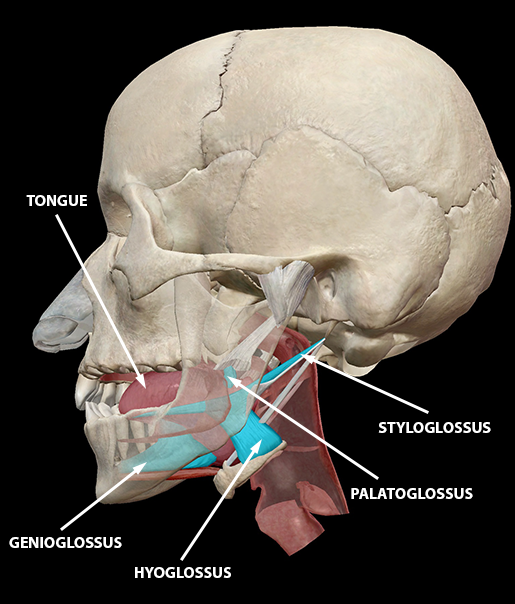
The tongue is one of the most active of the articulators in the vocal tract. It can impede the flow of air by coming in contact with the oropharyngeal wall, soft palate (velum), hard palate, and alveolar ridge (the part of the hard palate just behind the front teeth).
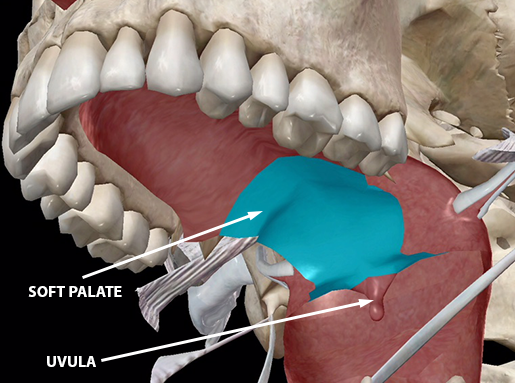
It’s no wonder that the tongue has so many muscles helping it out—it needs to be pretty versatile to make the specific movements required for speech! Movements of the mouth, face, tongue, and larynx are so important, in fact, that a large portion of the primary motor cortex is devoted to them.
You might recognize the image below (the motor homunculus) from the neuromuscular interaction article from a few weeks back. The face/tongue/larynx and hands are depicted as the largest parts of the body in the homunculus representation because of the large regions of motor cortex devoted to their intricate motions.
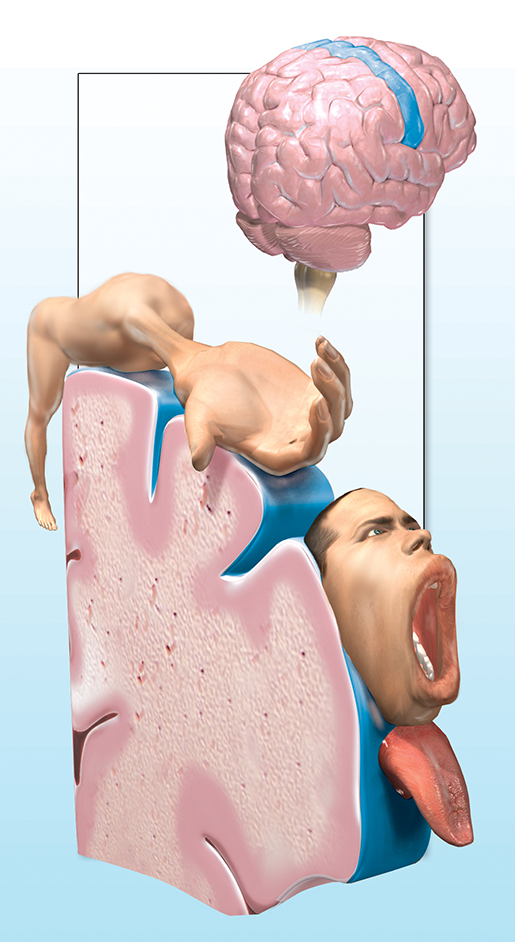
Speech Sounds: Let's Make Some Noise!
Now we’re going to put all the muscle-y stuff together with some linguistics to give a more complete picture of how the motions of your articulators create particular sounds.
Phoneticians (linguists who study the articulatory and/or acoustic properties of speech sounds) have grouped the speech sounds humans make into several categories. There are vowels and consonants, of course, but there are also lots of smaller distinctions within those categories.
Let’s start with vowels. Vowels don’t involve stopping the stream of air as it travels up from the lungs, but they do involve changing the shape and size of the space through which the air passes. The vocal cords must also be vibrating in order for a vowel sound to be produced. If you’re an English speaker, try going through the vowel sounds “ah” “ey” “ee” “oh” and “ooh” and pay attention to how the shape of your lips and the amount of space inside your mouth changes. Vowel sounds can also combine to form diphthongs .
Linguists typically group vowels based on their tongue height (high, mid, low), tension (tense, lax), and tongue position (front, central, back) as well as whether the lips are rounded.
In contrast, a consonant is basically any sound that isn’t a vowel. They involve stopping the flow of air, either fully or partially, and releasing it again. Consonants are categorized by their place and manner of articulation.
The place of articulation refers to the point at which the airflow is impeded. This can occur at the lips, teeth, alveolar ridge, hard palate, soft palate, uvula, oropharyngeal wall, epiglottis, and glottis. Much of the time, the tongue is responsible for blocking the air stream, but glottal, epiglottal, bilabial (lips are pressed together), and labiodental (top teeth press against bottom lip) sounds are notable exceptions to this generalization.
The manner of articulation refers to what happens to the air. Stop consonants (p, b, t, d, k, hard g) completely obstruct the flow of air before releasing it again. Fricatives (like s or f) create a narrow space for air to pass through, giving them a hissing sound. Affricates (ch, j) are roughly between a stop and a fricative. Approximants (r, l, w, y) involve articulators coming close enough together to qualify as a consonant rather than a vowel, but no friction is created.
Nasal sounds (like English n, m, and ng) are not your average consonants. Basically, airflow is blocked in the mouth, as in a stop consonant, but the air is allowed to flow out through the nasal cavity because the velum (soft palate) is lowered.
Pathologies
When we string sounds and syllables into words and phrases, the primary motor cortex works together with regions of the brain, such as Broca’s area (BA 44–45), that deal with computational aspects of language production. Damage to Broca’s area results in expressive aphasia ( Broca’s aphasia ), which is characterized by patients having difficulty producing fluent speech, especially when complex grammar is required.
There are also a number of pathologies that can affect the articulatory/neuromuscular component of speech production.
One of these is dysarthria , in which neurological damage from stroke, traumatic brain injury, or degenerative disorders (ALS, MS, Dementia) makes it difficult to move the muscles that produce speech sounds. This is due to a disruption in the transmission of motor signals from the brain to the articulators. Direct damage to the speech organs can result in a condition called peripheral dysarthria. Typical symptoms of dysarthria include speech that is too fast or slow, slurred, or mumbled. People with dysarthria may also have trouble moving their jaw, tongue, or lips.
Another condition affecting speech articulation is a developmental disorder called childhood apraxia of speech (CAS) . Potential causes for CAS can include (but are not limited to) brain damage or underlying genetic conditions. Unlike dysarthria, CAS does not involve muscle weakness. Children with CAS do still have trouble moving their muscles to make speech sounds, but this problem lies more with motor planning than disruptions in the transmission of signals from brain to muscle. Whew! That was a lot of sounds. And just think—every time you speak, your brain and muscles coordinate the required movements at lightning speed! What’s more, the sounds of English are only a piece of the full sound inventory of the world’s languages. Check out UCLA’s phonetics archive to learn more (you can listen to just about any type of speech sound on this site—it’s awesome!).

Be sure to subscribe to the Visible Body Blog for more anatomy awesomeness!
Are you a professor (or know someone who is)? We have awesome visuals and resources for your anatomy and physiology course! Learn more here. Additional Sources:
Phonation Types
Cortical Language Areas
Evolution of the Vocal Tract
Human vs. Ape Vocal Tracts
Human Vocal Tract & Child Language Development
- Anatomy & Physiology
Get free instructor access to Courseware
Subscribe to the visible body blog, most popular.

For students
For instructors
Get our awesome anatomy emails!
When you select "Subscribe" you will start receiving our email newsletter. Use the links at the bottom of any email to manage the type of emails you receive or to unsubscribe. See our privacy policy for additional details.
- Teaching Anatomy in 3D
- Teaching Biology in 3D
- For K-12 Instructors
- K-12 Funding Guide
- Premade Courses
- Anatomy Learn Site
- Biology Learn Site
- Visible Body Blog
- eBooks and Lab Activities
- Premade Tours
- Premade Flashcard Decks
- Customer Stories
- Company News
- Support Site
- Courseware FAQ
- Submit a Ticket
©2024 Visible Body. All Rights Reserved.
- User Agreement
- Permissions

- History & Society
- Science & Tech
- Biographies
- Animals & Nature
- Geography & Travel
- Arts & Culture
- Games & Quizzes
- On This Day
- One Good Fact
- New Articles
- Lifestyles & Social Issues
- Philosophy & Religion
- Politics, Law & Government
- World History
- Health & Medicine
- Browse Biographies
- Birds, Reptiles & Other Vertebrates
- Bugs, Mollusks & Other Invertebrates
- Environment
- Fossils & Geologic Time
- Entertainment & Pop Culture
- Sports & Recreation
- Visual Arts
- Demystified
- Image Galleries
- Infographics
- Top Questions
- Britannica Kids
- Saving Earth
- Space Next 50
- Student Center
- Introduction
- Respiratory mechanisms
- Brain functions
- Cartilages of the larynx
- Extrinsic muscles
- Intrinsic muscles
Vocal cords
Esophageal voice, artificial larynx.
- The basic registers
- Studies of register differences
- Vocal frequency
- Voice types
- Vocal ranges
- Harmonic structure
- Vocal styles
- Individual voice quality
- Singing and speaking
- Synthetic production of speech sounds

- What did Martin Luther King, Jr., do?
- What is Martin Luther King, Jr., known for?
- Who did Martin Luther King, Jr., influence and in what ways?
- What was Martin Luther King’s family life like?
- How did Martin Luther King, Jr., die?

Our editors will review what you’ve submitted and determine whether to revise the article.
- American Speech-Language-Hearing Association - What is Speech? What is Language?
- Institute for Natural Language Processing - Voice quality: description and classification
- speech - Children's Encyclopedia (Ages 8-11)
- speech - Student Encyclopedia (Ages 11 and up)
- Table Of Contents
The two true vocal cords (or folds) represent the chief mechanism of the larynx in its function as a valve for opening the airway for breathing and to close it during swallowing . The vocal cords are supported by the thyroarytenoid ligaments, which extend from the vocal process of the arytenoid cartilages forward to the inside angle of the thyroid wings. This anterior insertion occurs on two closely adjacent points, the anterior commissure. The thyroarytenoid ligament is composed of elastic fibres that support the medial or free margin of the vocal cords.
The inner cavity of the larynx is covered by a continuous mucous membrane , which closely follows the outlines of all structures. Immediately above and slightly lateral to the vocal cords, the membrane expands into lateral excavations, one ventricle of Morgagni on each side. This recess opens anteriorly into a still smaller cavity, the laryngeal saccule or appendix. As the mucous membrane emerges again from the upper surface of each ventricle, it creates a second fold on each side—the ventricular fold , or false cord. These two ventricular folds are parallel to the vocal cords but slightly lateral to them so that the vocal cords remain uncovered when inspected with a mirror. The false cords close tightly during each sphincter action for swallowing; when this primitive mechanism is used for phonation, it causes the severe hoarseness of false-cord voice ( ventricular dysphonia).
The mucous membrane ascends on each side from the margins of the ventricular folds of the upper border of the laryngeal vestibule, forming the aryepiglottic folds. These folds extend from the apex of the arytenoids to the lateral margin of the epiglottis. Laterally from this ring enclosing the laryngeal vestibule, the mucous membrane descends downward to cover the upper-outer aspects of the larynx where the mucous membrane blends with the mucous lining of the piriform sinus of each side. These pear-shaped recesses mark the beginning of the entrance of the pharyngeal foodway into the esophagus.
The mucous membrane of the larynx consists of respiratory epithelium made up of ciliated columnar cells. Ciliated cells are so named because they bear hairlike projections that continuously undulate upward toward the oral cavity , moving mucus and polluting substances out of the airways. The true vocal cords, however, are exceptional in that they are covered by stratified squamous epithelium (squamous cells are flat or scalelike) as found in the alimentary tract . The arrangement is functional, since the vocal cords have to bear considerable mechanical strain during their rapid vibration for phonation, which occurs during many hours of the day. The transition from the respiratory to the stratified epithelium above and below the vocal cords is marked by superior and inferior arcuate (arched) lines. Unfortunately, such transitional epithelium also has the drawback of being easily disturbed by chronic irritation, which is one reason why the large majority of laryngeal cancers begin on the vocal cords. The mucous membrane of the larynx contains numerous mucous glands in all areas covered by respiratory epithelium, excepting again the vocal cords. These glands are especially numerous over the epiglottis and in the ventricles of Morgagni. The mucus secreted by these glands serves as a lubricant for the mucous membrane and prevents its drying in the constant airstream.

The vocal cords also mark the division of the larynx into an upper and lower compartment. These divisions reflect the development of the larynx from several embryonal components called branchial arches . The supraglottic portion differs from the one beneath the vocal cords in that the upper portion is innervated sensorially by the superior laryngeal nerve and the lower (infraglottic) portion by the recurrent (or inferior) laryngeal nerve. The lymphatics (i.e., the vessels for the lymph flow) from the upper portion drain in an upward lateral direction, while the lower lymphatics drain in a lateral downward direction.
The space between the vocal cords is called rima glottidis, glottal chink, or simply glottis (Greek for tongue). When the vocal cords are separated (abducted) for respiration , the glottis assumes a triangular shape with the apex at the anterior commissure. During phonation, the vocal cords are brought together (adducted or approximated), so that they lie more or less parallel to each other. The glottis is the origin of voice, although not in the form of a “fluttering tongue” as the Greeks believed.
The vocal cords vary greatly in dimension, the variance depending on the size of the entire larynx, which in turn depends on age, sex, body size, and body type. Before puberty, the larynx of boys and girls is about equally small. During puberty , the male larynx grows considerably under the influence of the male hormones so that eventually it is approximately one-third larger than the female larynx. The larynx and the vocal cords thus reflect body size. In tall, heavy males the vocal cords may be as long as 25 millimetres (one inch), representing the low-pitched instrument of a bass voice. A high-pitched tenor voice is produced by vocal cords of the same length as in a low-voiced female contralto. The highest female voices are produced by the shortest vocal cords (14 millimetres), which are not much longer than the infantile vocal cords before puberty (10–12 millimetres). The larynx is, among other things, a musical instrument that follows the physical laws of acoustics fairly closely.
Substitutes for the larynx
A growing number of middle-aged or older patients have had their larynx removed ( laryngectomy ) because of cancer . Laryngectomy requires the suturing of the remaining trachea into a hole above the sternum (breastbone), creating a permanent tracheal stoma (or aperture) through which the air enters and leaves the lungs. The oral cavity is reconnected directly to the esophagus. Having lost his pulmonary activator (air from the lungs) and laryngeal sound generator, such an alaryngeal patient is without a voice ( aphonic) and becomes effectively speechless; the faint smacking noises made by the remaining oral structures for articulation are practically unintelligible. This type of pseudo-whispering through buccal (mouth) speech is discouraged to help the patient later relearn useful speech on his own. A frequently successful method of rehabilitation for such alaryngeal aphonia is the development of what is called esophageal or belching voice.
Some European birds and other animals can produce a voice in which air is actively aspirated into the esophagus and then eructated ( belched ), as many people can do without practice. The sound generator is formed by the upper esophageal sphincter (the cricopharyngeus muscle in humans). As a replacement for vocal cord function, the substitute esophageal voice is very low in pitch , usually about 60 cycles per second in humans. Training usually elevates this grunting pitch to about 80 or 100 cycles.
Esophageal voice in humans has been reported in the literature since at least 1841 when such a case was presented before the Academy of Sciences in Paris. After the perfection of the laryngectomy procedure at the end of the 19th century, systematic instruction in esophageal (belching) phonation was elaborated, and the principles of this vicarious phonation were explored. Laryngectomized persons in many countries often congregate socially in “Lost Cord Clubs” and exchange solutions of problems stemming from the alaryngeal condition.
Approximately one-third of all laryngectomized persons are unable to learn esophageal phonation for various reasons, such as age, general health, hearing loss , illiteracy, linguistic barriers, rural residence, or other social reasons. These persons, however, can use an artificial larynx to substitute for the vocal carrier wave of articulation. Numerous mechanical and pneumatic models have been invented, but the modern electric larynx is most serviceable. It consists of a plastic case about the size of a flashlight, containing ordinary batteries , a buzzing sound source, and a vibrating head that is held against the throat to let the sound enter the pharynx through the skin. Ordinary articulation thus becomes easily audible and intelligible. Other models lead the sound waves through a tube into the mouth or are encased in a special upper dental plate. More recent efforts aim at surgically inserting an electric sound source directly into the neck tissues to produce a more natural sound resembling that of normal speech.
How do we Produce and Understand Speech?
- First Online: 30 August 2024
Cite this chapter

- Joanna Dornbierer-Stuart 2
A comprehensive model of language evolution should not only describe the structure of the communication system that has evolved but also define the mechanisms underlying its use. This chapter therefore enters the realm of psycholinguistics and speech processing and looks at the mechanisms involved in generating speech (speech production) and understanding the speech of someone else (speech perception). The chapter focuses on models of speech processing and also turns to some evidence from neuroscience to aid our understanding of how language is processed in the brain.
This is a preview of subscription content, log in via an institution to check access.
Access this chapter
Institutional subscriptions
Field, J. (2004). Psycholinguistics . Routledge.
Google Scholar
Schmid, H.-J. (2012). Linguistic theories, approaches and methods . In M. Middeke, T. Müller, C. Wald, & H. Zapf (Eds.), English and American studies . J. B. Metzler.
Levelt, W. (1989). Speaking: From intention to articulation . The MIT Press.
Levelt, W. (1995). The ability to speak: From intentions to spoken words. European Review, 3 (1), 13–23. https://doi.org/10.1017/S1062798700001290
Article Google Scholar
Levelt, W. (1993). The architecture of normal spoken language use. In G. Blanken, J. Dittman, H. Grimm, J. C. Marshall, & C.-W. Wallesch (Eds.), Linguistic disorders and pathologies: An international handbook (pp. 1–15). Walter de Gruyter.
Wernicke, C. (1874). Der aphasische Symptomencomplex: eine psychologische Studie auf anatomischer Basis . Cohn & Weigert.
Lichtheim, L. (1885). Über Aphasie. Deutsches Archiv für klinische Medizin, 36 , 204–268.
Federmeier, K. D., & Kutas, M. (1999). A rose by any other name: Long-term memory structure and sentence processing. Journal of Memory and Language, 41 , 469–495. https://doi.org/10.1006/JMLA.1999.2660
Liberman, A. M., Cooper, F. S., Shankweiler, D. P., & Studdert-Kennedy, M. (1967). Perception of the speech code. Psychological Review, 74 (6), 431–461. https://doi.org/10.1037/h0020279
di Pellegrino, G., Fadiga, L., Fogassi, L., Gallese, V., & Rizzolatti, G. (1992). Understanding motor events: A neurophysiological study. Experimental Brain Research, 91 , 176–180. https://doi.org/10.1007/BF00230027
Rizzolatti, G., & Arbib, M. A. (1998). Language within our grasp. Trends in Neurosciences, 21 (5), 188–194. https://doi.org/10.1016/s0166-2236(98)01260-0
Günther, F., Dudschig, C., & Kaup, B. (2017). Symbol grounding without direct experience. Cognitive Science, 42 (2), 336–374. https://doi.org/10.1111/cogs.12549
Friederici, A. D. (2002). Towards a neural basis of auditory sentence processing. Trends in Cognitive Sciences, 6 (2). https://doi.org/10.1016/S1364-6613(00)01839-8
Wei, X., Adamson, H., Schwendemann, M., Goucha, T., Friederici, A. D., & Anwander, A. (2023). Native language differences in the structural connectome of the human brain . Max Planck Institute for Human Cognitive and Brain Science, Department of Neuropsychology, Leipzig, Germany.
Download references

Author information
Authors and affiliations.
School of English, Birmingham City University, Birmingham, UK
Joanna Dornbierer-Stuart
You can also search for this author in PubMed Google Scholar
Corresponding author
Correspondence to Joanna Dornbierer-Stuart .
Rights and permissions
Reprints and permissions
Copyright information
© 2024 The Author(s), under exclusive license to Springer Nature Switzerland AG
About this chapter
Dornbierer-Stuart, J. (2024). How do we Produce and Understand Speech?. In: The Origins of Language. Palgrave Macmillan, Cham. https://doi.org/10.1007/978-3-031-54938-0_7
Download citation
DOI : https://doi.org/10.1007/978-3-031-54938-0_7
Published : 30 August 2024
Publisher Name : Palgrave Macmillan, Cham
Print ISBN : 978-3-031-54937-3
Online ISBN : 978-3-031-54938-0
eBook Packages : Social Sciences Social Sciences (R0)
Share this chapter
Anyone you share the following link with will be able to read this content:
Sorry, a shareable link is not currently available for this article.
Provided by the Springer Nature SharedIt content-sharing initiative
- Publish with us
Policies and ethics
- Find a journal
- Track your research
JavaScript seems to be disabled in your browser. For the best experience on our site, be sure to turn on Javascript in your browser.
- Create an Account
application
At Home Gaming High-End
Portable
Studio & Creator
Active Noise Cancelling Bluetooth ® Customisable Sound Personalization
Tesla Technology
MOBILe work
Gaming guide, mosayc & miy app, tesla technology, discover more.
- DT 770 PRO X Limited Edition
MMX 200 wireless
New mmx 330 pro, mmx 300 pro, application.
Acoustic Guitar
Drums & Percussion
E-Guitar & E-Bass
Home office
Home recording
Measurement
Speech & Presentation
Wind Instrument
Other Instruments
Surroundings
Conference Office & Home office Presentation Stage Studio & Home Studio
Acoustic GuitarS
Discover more, m series facelift.
Gaming headsets Gaming headphones
Streaming microphones
HEADSETS AND HEADPHONES
New mmx 330 pro, gaming guide, personalized sound.
Mixing & Mastering
Recording Headphones
Recording Microphones
Tesla technology
find your perfect product within 60 sec.
Let us advise you >
Most wanted
Dt 700 pro x, dt 1990 pro, dt 900 pro x, mobile work: headsets, headphones and speakerphones, space max.
- MMX 300 PRO
xelento wireless
xelento remote, service & support.
Catalogues
Dealer Finder Downloads Extranet
Registration
Spare Parts Warranty
If you purchased your beyerdynamic product less than two years ago, you still have your purchase receipt, and you have not violated the terms and conditions of your warranty through improper use: Service and repair fees are covered by your warranty.
For further instructions, please follow this link to get in contact with our authorized service provider in the U.S.
Consolidated Sound Services >
We want you to be completely satisfied with your order and our products. In case you are not fully satisfied and wish to return the ordered items, just follow our instructions for a quick and easy return of your items.
RETURN - STEP BY STEP >
Complaints & Repairs
Conference systems & headsets, frequently asked questions.
How can I connect Amiron wireless to my TV?
What's the difference between the DT770/990 PRO and the DT 1770/1990 PRO?
Which DT 770 for which source?
What is meant by "Tesla technology"?
Which pair of headphones are the best DT 770 PRO, DT 880 PRO or DT 990 PRO?
What are the differences between MMX 300 (2nd gen.) and Custom Game?
Show all help topics
- Switzerland
- The Netherlands
- United States
- International
- PRO DEALS: Discover our PRO Deals and benefit from our attractive bundle deals! View Deals >
- OUTLET: Refurbished headphones & microphones at reduced prices! Discover now!
- Popular searches
- beyerdynamic SPACE MAX
- Firm-/ Software Update
- Amiron wireless Update
- My Wish List

Save up to 10% on PRO products and our special bundle deals! View Deals > PRO DEALS >
Only left to save up to 10%! View Deals > PRO DEALS >
Widget erscheint:
Widget verschwindet:
Startzeitpunkt Countdown:
Endzeitpunkt Countdown:
Textbanner erscheint:
Textbanner verschwindet:
Tage verstecken:
MMX 330 PRO
- Open sound for an immersive gaming experience
- High speech intelligibility thanks to broadcast quality microphone
- Maximum comfort for extended gaming sessions
- Earpads, headband and cable as replacement parts
- Made in Germany
Delivery time: Orders processed and shipped promptly
Mobile devices
Headphones for when you’re out and about but not prepared to compromise on studio sound.
Universal studio
These 80-ohm headphones are the ideal choice for a range of studio applications.
Professional devices
With an impedance of 250 ohm, the DT 770 PRO headphones are perfect for mixing in the studio.
Stationary & mobile devices
Ideal for universal use on stationary and mobile devices (tablets or smartphones, etc.).
Stereo systems
Primarily designed for use with older home stereo systems with medium-impedance headphone output.
HI-FI systems
Suitable for hi-fi systems with particularly powerful headphone outputs or for use with special headphone amplifiers.
- Characteristics
Technical Data
- Product Reviews
- Accessories
MMX 330 pro
With comprehensive studio-level sound and crystal-clear voice transmission, the open-back MMX 330 PRO gaming headset gives you a decisive advantage.
OPEn sound for a competitive advantage
Always be one step ahead of your opponents with the MMX 330 PRO. The open-back gaming headset combines high-quality studio drivers, a wide sound stage, excellent microphone quality and high wearing comfort. This gives you a significant advantage over your fellow players. Made by hand in Germany, the MMX 330 PRO can easily survive even the most intensive gaming sessions.
Product highlights
Check out our blog post to learn all about the key differences between the MMX 330 PRO and the MMX 300 PRO.
MMX 330 PRO vs. MMX 300 PRO >
POWERFUL ON pc & CONSOLE
Thanks to the low-impedance STELLAR.45 driver, the MMX 330 PRO can be used on all devices such as PC, PlayStation, Xbox, and Nintendo Switch. Operation on consoles is ensured with the Y adapter, which comes together with the headset.
Some Headline
Some paragraph
Dynamischer Manufaktur Button
Jetzt personalisieren!
/mmx-330-pro-manufaktur.html?cid=personalisierung
studio sound meets GAMING
At the heart of the new gaming headset MMX 330 PRO is the STELLAR.45 driver, which is also used in our studio headphones. The sound tuning is designed to keep you one step ahead of your fellow players. The open-back gaming headset boasts a high level of spatial definition. Acoustic in-game events can be pinpointed immediately. The MMX 330 PRO is also impressive when it comes to music playback.
MORE ABOUT STELLAR.45 >
EXCELLENT SPEECH INTELLIGIBILITY
Voice commands often make the difference between victory and defeat. The MMX 330 PRO has a high-quality condenser microphone that reproduces voices naturally. Every shot call can be clearly understood by team members. Thanks to the cardioid polar pattern, the microphone prioritises voices while remaining resistant to signals from other directions.
EXCELLENT SPEECH INTELLIGIBILITY
Voice commands often make the difference between victory and defeat. The MMX 330 PRO has a high-quality condenser microphone that reproduces voices naturally. Every shot call can be clearly understood by team members. Thanks to the cardioid polar pattern, the microphone prioritises voices while remaining resistant to signals from other directions.
UNPARALLELED WEARING COMFORT
The MMX 330 PRO is extremely comfortable to wear, even over several hours. This is partly down to the comfortable velour ear pads. The buttoned head cushion adapts to the shape of the head thanks to soft memory foam. The integrated fontanelle recess avoids potentially pain-sensitive areas on the head and ensures even greater comfort.
HANDMADE in Germany
The MMX 330 PRO open-back gaming headset is handmade in Germany and boasts excellent craftsmanship. The combination of robust metal parts and impact- and scratch-resistant plastic makes the MMX 330 PRO a reliable companion. In the interest of sustainability, we make replacement ear pads, headbands and cables available for many years to come.
Handmade in GERMANY
Any questions left.
All FAQs >
- What is the difference between the MMX 330 PRO and the MMX 300 PRO?
The MMX 330 PRO is an open-back gaming headset that we offer as a counterpart to the closed MMX 300 PRO. Both headsets deliver high-quality sound that draws on our studio expertise. The open-back design results in a particularly natural, spatial and transparent playing experience. In comparison, the MMX 300 PRO offers greater sound insulation thanks to its closed design and is ideal if, for example, there are other players in the room and no sound should escape to the outside. The bass reproduction on the MMX 300 PRO is more pronounced than on the MMX 330 PRO due to the closed design. As with the MMX 300 PRO, the MMX 330 PRO features the powerful STELLAR.45 driver, a high-quality condenser microphone, and it offers excellent comfort. The high product quality is achieved thanks to manufacturing in Germany.
+ Does the MMX 330 PRO work on consoles as well?
Yes, the MMX 330 PRO works with PS5, PS4, XBox, Nintendo Switch and other consoles using 3.5 mm connectivity.
- Are the ear pads of the MMX 300 PRO compatible with the MMX 330 PRO?
The ear pads of the MMX 330 PRO contribute significantly to the open sound of the headset. Therefore, specially designed ear pads are used for this headset, which are not compatible with the MMX 300 PRO.
WHAT'S IN THE BOX
DAT_MMX330PRO_EN_.pdf (217.07 KB)
MAN_MMX330PRO_EN-DE-FR-ES-IT-SV-JA-ZH_.pdf (5.40 MB)
More Downloads
In the service area

IMAGES
VIDEO
COMMENTS
Three more parts of the speech mechanism and organs of speech are the larynx, epiglottis and vocal folds. The larynx is covered by a flap of skin called the epiglottis. The epiglottis blocks the trachea to keep food from going into your lungs when you swallow. Across the larynx are two thin bands of tissue called the vocal folds or vocal cords.
Also known as Articulators, The Organs of Speech are the different parts of the human body involved in the production of speech sounds. They help in one way or the other in producing speech sounds.
Speech is human communication through spoken language. Although many animals possess voices of various types and inflectional capabilities, humans have learned to modulate their voices by articulating the laryngeal tones into audible oral speech. Learn more about speech in this article.
How do we breathe and speak? This animated video on vocal mechanics from the National Institute on Deafness and Other Communication Disorders (NIDCD) at the ...
Chapter 11.2 The organs of speech When we speak, we use our vocal tracts to produce sounds, or phones. Before examining the sounds we make in English, it is helpful to understand what these organs are and how they are used.
2.2 The Articulatory System We speak by moving parts of our vocal tract (See Figure 2.1). These include the lips, teeth, mouth, tongue and larynx. The larynx or voice box is the basis for all the sounds we produce. It modified the airflow to produce different frequencies of sound. By changing the shape of the vocal tract and airflow, we are able to produce all the phonemes of spoken language ...
Organs of Speech There are approximately 100 muscles in the human body, and most work closely together in a coordinated manner in order to produce speech.
2.1 How Humans Produce Speech Phonetics studies human speech. Speech is produced by bringing air from the lungs to the larynx (respiration), where the vocal folds may be held open to allow the air to pass through or may vibrate to make a sound (phonation).
Conventionally, these are called the organs of speech, and the use in several languages of the same word for the tongue as a part of the body and for language shows the awareness people have of the role played by this part of the mouth in speaking. But few if any of the major organs of speech are exclusively or even mainly concerned with speaking.
How Does the Human Body Produce Voice and Speech? Speech is produced by several parts of the body working together to shape the sounds of the voice. 4 Mouth and Nose Coordinated movements mainly by the tongue and lips and in the nasal passages that produce recognizable sounds called speech.
[back to infographic]How Does the Human Body Produce Voice and Speech?Speech is produced by several parts of the body working together to shape the sounds of the voice.1. LungsVoice is generated by airflow from the lungs.When the air from the lungs blows through the vocal folds at a high speed, the vocal folds vibrate.The vibrations lead to sounds we call voice. These sounds are shaped to form ...
phonetics, the study of speech sounds and their physiological production and acoustic qualities. It deals with the configurations of the vocal tract used to produce speech sounds (articulatory phonetics), the acoustic properties of speech sounds (acoustic phonetics), and the manner of combining sounds so as to make syllables, words, and sentences (linguistic phonetics).
In this Video, you will learn about the organs of speech and be able to define their functions. It is very important to understand the anatomy of speech before you jump into sounds.
Articulation: The process by which raw phonation from the vocal cords is refined into specific sounds, such as consonants and vowels. glottis: An organ of speech located in the larynx and consisting of the true vocal cords and the opening between them. Voice production is a complex process with many different layers and intricacies.
These include the brain, the respiratory organs, and the organs in our neck and mouth. A thorough understanding of the mechanism of speech production has helped correct speech disorders, simulate speech through machines, and develop devices for people with speech related needs.
Direct damage to the speech organs can result in a condition called peripheral dysarthria. Typical symptoms of dysarthria include speech that is too fast or slow, slurred, or mumbled. People with dysarthria may also have trouble moving their jaw, tongue, or lips.
Some organs are helpful in differentiating the sounds through articulation. Lungs. They act as the main source of energy for speech. It has small air pockets called alveoles in which oxygen is stored. When the air in the alveolus is pushed up, the displaced air comes up the windpipe (trachea) and reaches the larynx.
The document discusses the organs of speech and their roles in producing sound. It describes the larynx containing vocal cords that vibrate to produce voice when air passes through. The pharynx and soft palate direct air to the mouth or nasal cavity. The tongue can move in different positions and directions, and the lips can take various positions. The organs of speech are divided into active ...
Speech - Vocal Cords, Phonation, Articulation: The two true vocal cords (or folds) represent the chief mechanism of the larynx in its function as a valve for opening the airway for breathing and to close it during swallowing. The vocal cords are supported by the thyroarytenoid ligaments, which extend from the vocal process of the arytenoid ...
ABSTRACT Each organ of speech or articulator plays a special role in the production of speech sounds; and these speech sounds ease human communication. The tongue, lips, teeth, lungs, vocal cords, velum, soft and hard palate, larynx and pharynx among others help to ease human communication. This work examines organ of speech or articulator, its functions and pedagogical implications. The ...
THE ORGANS OF SPEECH It should be mentioned that the human being does not possess the organs which are exclusively used for producing speech sounds. All the organs involved in pronunciation of speech sounds, and human speech in general, primarily fulfil other functions - the functions of swallowing and digesting food, respiratory functions, etc.
226 The Organs of Speech, the lead among us in the enthusiasm at present imparted to the instruction in articulation of the congeni tally deaf - a work of education which, at Paris, the public has seen for the first time made general in the special school in the Avenue de Villiers, generously founded and endowed by the Pereire family.
In the past, psycholinguists gained insights into speech processes using two methods. The first method was to study the speech of aphasics (people who have a linguistic deficit, or aphasia, following damage to a part of the brain involved in language).As we saw in Chapter 4, aphasic individuals often exhibit selective impairments in one of the broad categories of speech production (Broca's ...
SPEECH INTELLIGIBILITY. Voice commands often make the difference between victory and defeat. The MMX 330 PRO has a high-quality condenser microphone that reproduces voices naturally. ... + Does the MMX 330 PRO work on consoles as well? -Are the ear pads of the MMX 300 PRO compatible with the MMX 330 PRO? The ear pads of the MMX 330 PRO ...